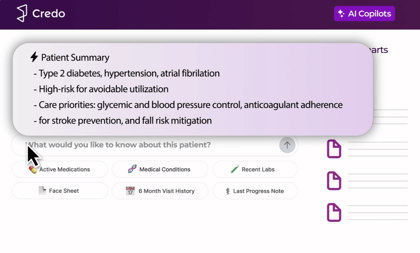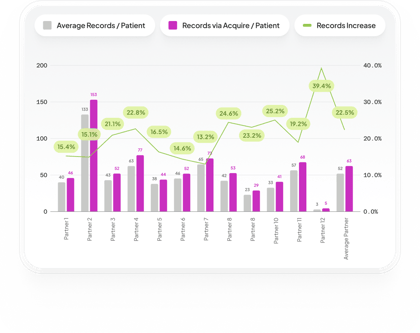Raising RAF With Integrity Starts With Complete Data
.png?width=360&height=255&name=Credo-25-Chart-ProductValidation-Inspect%20(1).png)
I have the privilege of partnering with exceptional MSOs and ACOs that work tirelessly to care for our most vulnerable populations under value-based contracts. These teams live the reality that accurate RAF is not a back-office metric. It is the fuel that keeps access, staffing, and care programs alive. When RAF is wrong because data is missing or low-fidelity, the consequences are immediate. Missed diagnoses, denied documentation, and financial pressure can derail even the best-run organizations.
 Last week we announced Care Map. In one sentence, Care Map finds where a patient has actually received care, retrieves the records digitally through our connections to national and regional HIEs like Carequality, CommonWell, eHealth Exchange, and Healthix, and then closes the remaining 30 to 50 percent of non-digital gaps with agent-assisted retrieval. The result is a 30 to 50 percent increase in chart retrieval, delivery in days instead of weeks, at a fraction of historical costs, with every record preserved with source citations.
Last week we announced Care Map. In one sentence, Care Map finds where a patient has actually received care, retrieves the records digitally through our connections to national and regional HIEs like Carequality, CommonWell, eHealth Exchange, and Healthix, and then closes the remaining 30 to 50 percent of non-digital gaps with agent-assisted retrieval. The result is a 30 to 50 percent increase in chart retrieval, delivery in days instead of weeks, at a fraction of historical costs, with every record preserved with source citations.
We have all watched strong operators struggle. In recent months, several high-profile ACO programs have scaled back or exited. This is a reminder that great intentions and great teams can still get crushed on risk adjustment when the record is incomplete. If we want the ACO REACH model to work and value-based care to actually improve outcomes, we have to start with complete, trusted clinical histories.
Why Care Map Was Essential
Care Map changes what is possible for suspecting, both prospective and retrospective, because it changes the data. Care Map finds where a patient has actually received care and retrieves records digitally via our on-ramp to the Carequality trust framework and national HINs, including CommonWell and the eHealth Exchange, plus the regional HIE Healthix. We then systematically chase the 30 to 50 percent of high-value records that do not return digitally. This is how we deliver a 30 to 50 percent increase in chart retrieval, in days instead of weeks, at a fraction of historical costs.
Complete input leads to high-fidelity inspection and higher physician acceptance. This is how you raise RAF with integrity.
.png?width=458&height=324&name=Credo-25-Chart-ProductValidation-Inspect%20(1).png) What This Means for Suspecting
What This Means for Suspecting
Prospective lift in year. Charts arrive quickly. Evidence-backed suspects appear while they still influence care. Clinicians confirm and document in the visit, not months later.
A smaller and smarter retro. Documentation lag shrinks. Non-digital gaps are closed. When retrospective coding is still needed, it runs on higher-signal data. That means fewer walk-backs and fewer denials.
Provider trust by design. Native context such as notes, imaging, labs, medications, and problem lists is preserved. Every item is source-cited. Clinicians can verify in seconds, which makes acceptance faster and more defensible.
Proof: Anonymized “Precision Pilot”
A national value-based organization ran a head-to-head evaluation across 500 high-risk Medicare patients. Both vendors received the same cohort, sourced records independently, identified HCCs, and delivered findings to clinicians.
-
Total HCCs identified: approximately 1,000 versus approximately 1,000.
-
Overlap: about 10 percent, which indicates very different signal quality.
-
Accepted at the point of care: 55 percent for Credo, or about 550 accepted, versus 30 percent for the incumbent, or about 300 accepted.
-
Net-new accepted HCCs: 425 for Credo versus 200 for the incumbent.
Why the edge:
-
Care Map provided broader and deeper record coverage, including the non-digital remainder that others miss.
-
Inspect applied precision-first inferencing tuned for provider adoption with audit-ready evidence.
The result was more than two times the net-new accepted HCCs from the same patients and a multi-year extension based on value delivered.
Commercial Impact You Can Model
-
Reclaim 20 to 40 percent of staff time currently lost to manual record chase and pre-visit prep.
-
Avoid legacy copy and processing fees, often 150 to 250 dollars per chart, by going digital first and reserving last-mile retrieval for what truly matters.
-
Focus on the metric that moves RAF: accepted suspects supported by complete, cited records.
The Bottom Line
Some of the best organizations serving the neediest patients are getting squeezed by incomplete data. Care Map puts high-fidelity inspection on steroids. You get more charts, better context, and higher physician acceptance. RAF reflects reality, not noise. If you are ready to move from more suspects to more accepted suspects, we are ready to help.
For a complete rundown of our platform, please watch this video.
Back to blog


.png?width=420&height=297&name=Credo-25-Chart-ProductValidation-Inspect%20(1).png)


